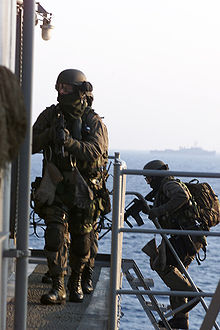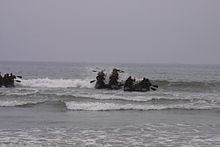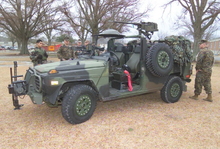- United States Marine Corps Force Reconnaissance
-
Not to be confused with Marine Division Reconnaissance.
Marine Force Reconnaissance 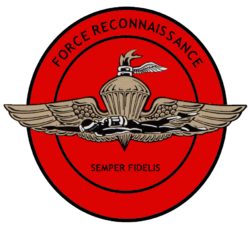
The insignia of 'Force Recon'.Active June 19, 1957–present Country  United States
United StatesBranch  United States Marine Corps
United States Marine CorpsType Special Operations Capable (SOC) Role Direct support of Marine Air-Ground Task Force Size ~400 (officers and enlisted) Part of Fleet Marine Force (FMF) Nickname Force Recon, FORECON Patron Dion Williams
James L. Jones, Sr.
Bruce F. Meyers
Joseph Z. TaylorMotto Celer, Silens, Mortalis
("Swift, Silent, Deadly")Engagements Vietnam War
Operation Urgent Fury
Operation Just Cause
Operation Desert Storm
Operation Restore Hope
Operation Enduring Freedom
Operation Iraqi FreedomThe Force Reconnaissance Companies (abbreviated as either 'Force Recon' or FORECON), are one of the United States Marine Corps's special operations "capable" forces (S.O.C.) that provide essential elements of military intelligence to the command element of the Marine Air-Ground Task Force (MAGTF); supporting the landing or joint task force commanders, and their subordinate operating units of the Fleet Marine Force (FMF), either the expeditionary/amphibious forces of the Pacific (FMFPac), or Atlantic (FMFLant).[1]
Historically, the Force Recon companies, detachments and platoons performed both deep reconnaissance and direct action (DA) operations. Recently the DA missions are now primarily conducted by the new Marine Special Operations Teams (MSOT), due to the recent establishment of the U.S. Marine Special Operations Command (MARSOC) in 2006. MARSOC was formed from Force Recon's direct action platoons, taking the DA side of Force Recon's missions. This now allows the FORECON companies to primarily focus on intelligence-gathering for force commanders without training for and maintaining expertise in the two very disparate mission types. The remaining deep reconnaissance platoons, which now comprise the whole entity of Force Recon, are capable of conducting such DA missions—and other supportive arms—if the MSOTs are unavailable.
FORECON is fully capable of operating independently behind enemy lines performing unconventional special operations, in support of conventional warfare. Their combined methods of airborne, heliborne and waterborne insertions and extractions are similar to those of the United States special operations forces of USSOCOM (e.g. Navy SEALs, Army Special Forces, United States Army Rangers, or Air Force Combat Controllers), although Force Recon's missions and tasks do differ slightly with a focus on supporting expeditionary and amphibious operations.[2]
Contents
Mission
For further information, see United States Marine Corps Reconnaissance Battalions#Mission.Two different mission types emerged during the Vietnam War, which are still implemented in the Force Reconnaissance motives today: Key Hole and Sting Ray. These practices subsequently became contemporary as "deep reconnaissance", or green operations; and "direct action", which are known as black operations.
Key Hole patrols were designed purely around reconnaissance and surveillance; usually lightly equipped and armed with defensive weapons—evasive techniques were employed to break contact from the enemy should the need arise, avoiding contact with the enemy was paramount. Sting Ray operations were the exact opposite of Key Hole missions with goals more closely in line of offensive strikes, the FORECON operators were heavily armed and used artillery and/or naval gunfire support, if available.
However, what began as a 'key hole' patrol could become a 'sting ray' patrol with little warning. The versatility of FORECON is demonstrated when missions quickly turn, planned or not, from a deep reconnaissance patrol to a direct action engagement.[2]
Green Operations
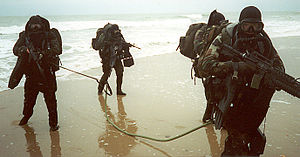 A four-man team of Marines simulate in infiltrating a beachhead to gain information about the enemy and its adjacent beaches to help forecast a 'ship-to-shore' landing operation as seen in the 1985 2nd Force Reconnaissance Company, II Marine Expeditionary Force, MCB Camp Lejeune, NC image above (from right to left) Team Leader LCPl James Hurt, LCPL Lawrence Gentile, CPL Michael Norton and LCPL Samuel Marquet.—example of green operations.
A four-man team of Marines simulate in infiltrating a beachhead to gain information about the enemy and its adjacent beaches to help forecast a 'ship-to-shore' landing operation as seen in the 1985 2nd Force Reconnaissance Company, II Marine Expeditionary Force, MCB Camp Lejeune, NC image above (from right to left) Team Leader LCPl James Hurt, LCPL Lawrence Gentile, CPL Michael Norton and LCPL Samuel Marquet.—example of green operations.
The principal mission of Force Recon is reconnaissance, to collect any pertinent intelligence of military importance, observe, identify and report adversaries to MAGTF commanders.[3] Like Division Recon (also known as the Marine Recon Battalions), they imply a mixed element of amphibious reconnaissance and ground reconnaissance. These missions are known as green operations. This practice fundamentally covers a wide spectrum of reconnaissance but primarily the FORECON operators conduct deep reconnaissance.
The Force Recon platoons operate farther inland than their Division Recon counterparts, penetrating deeper into enemy territory from their assigned littoral (coastal) region within a force commander's 'tactical area of responsibility' (TAOR). They operate at such great distances that they are beyond the boundaries, or fan, of any artillery and/or naval gunfire support (NGFS); unlike their Division Recon brethren, whose operations are primarily within the artillery and gunfire support fan. Silence and stealth are vital in reducing chances of compromising their position—if a single round is fired, the mission is deemed to have failed.
The United States Marine Corps Force Reconnaissance detachments, or FORECON, operate in deep reconnaissance, direct action, and the control of supporting arms; to convey military intelligence beyond the means of a commander's area of influence in the battlefield. They are capable of operating independently in combined methods of amphibious and ground operations by utilizing methods of conventional and unconventional warfare in defense of the United States.
Although Force Recon has never been part of the United States Special Operations Command, their missions slightly differentiate themselves from other United States Special Operations Forces units. Colloquially, they are specialized in all tactical areas of warfare. Force Recon will train with other Special Operations forces, such as, United States Navy SEALs, United States Army Special Forces, and United States Air Force Pararescue, in order to master all skill sets. The Marine Corps has seen fit to train versatile specialists rather than specialists in individual areas of combat.
Objectively, their reconnoitering roles (whether in elements of amphibious or ground) are an abstract of preliminary (or pre-'D-Day') and post-assault reconnaissance, which mainly consist of numerous missions, some examples are provided as such:
- battle damage assessment (BDA) missions–these missions involve witnessing and reporting collateral damage of target(s) caused by delivered payload, either from heavy support fire measures (artillery and naval gunfire support), high-explosive– or thermonuclear weapons.
- remote sensors operations[4]–placing remote sensors and beacons are vital for the marking friendly/hostile boundaries and areas for helicopter pilots, for assault or infantry transport, becoming detrimental for combat or logistic support; this mission has made pathfinding operations obsolete.
- initial terminal guidance (ITG)–setting up/preparing landing zones (LZ) and drop zones (DZ) for forward operating sites Marine fixed or rotary wing aircraft, possible future landing spots for parachute entry, or waterborne locations (landing force, ship-to-shore) operations.
Black Operations
Black operations are the missions that require direct action (DA). They are the opposite of green operations missions, where the Force Recon operators basically "look for trouble". Depending on the situation and the target location, the FORECON operators usually conduct direct action missions within the artillery and naval gun support fan; these operations demonstrate "small-scale" shock and awe.
Examples are the seizures and occupation of gas/oil platforms (GOPLAT) and the Visit, Board, Search, and Seizure (VBSS) of ships during Maritime Interdiction Operations (MIO), as well as orchestrating close air support, a vital skill exercised in DA missions; Force Recon operators forward observe from static positions and spider holes for artillery and naval gunfire support, or ordnance and payload delivery.
They provide Personal Security Detail (PSD) for critically important personnel. They are capable of performing In-Extremis Hostage Rescue (IHR) but this is no longer a Force Recon mission task.[5] The Maritime Special Purpose Force (MSPF) are designed for IHR missions for the MEF's subordinate Marine Expeditionary Unit (Special Operations Capable) [MEU (SOC)] in its stead.
Organization
In the past, early Force Reconnaissance companies in the Marine Corps had made numerous titular changes to its table of organization (T/O), so much so that it can be difficult to describe its primary command structure in detail. However, the companies initially were designed to function under the echelon of the Navy/Marine force commanders (e.g. under the direct operational control of the Commander, Amphibious Task Force (CATF) and Landing Force (CLF), and Fleet Marine Force) during amphibious landing operations or expeditionary engagements—to provide timely intelligence without exhausting their reconnaissance assets from the Marine Division without hampering their valuable support to its infantry regiments.
Due to these changes, FORECON has been detached and reported to multiple commanders of Marine divisions, the Command Elements (CE) of the Marine Air-Ground Task Forces, and the immediate commander of the Marine Expeditionary Force (MEF). They were re-organized or reserved for 'special reconnaissance' assignments that would otherwise help shape the outcome of his battlefield.[6] These companies, for a few times in their existence had either folded into the Marine Division, its Regiment's Recon Battalions, or dissolved entirely to only resurface during conflicts, or when other similar reasons had arisen.[2]
After the creation of Marine Special Operations Command (MARSOC) on August 11, 2006, it marked the United States Marine Corps' first commitment to the United States Special Operations Command (USSOCOM). By February 2006, 2nd FORECON deactivated its command.[7] The most experienced operators were selected to fill the ranks for the newly-established Marine Special Operations Battalions' (MSOBs) teams. A month later in January, 1st FORECON met the same fate.[8] The remaining Marines in both Force Recon companies molded into new "D" companies within the Division Recon Battalions, forming the Deep Reconnaissance Platoons (DRPs). The DRPs are designed to maintain and preserve the 'deep reconnaissance' assets to the MAGTF commanders.
In October 2008, by the direction of the Commandant of the Marine Corps (CMC), the D companies within both 1st and 2nd Reconnaissance Battalions were redesignated as "Force Reconnaissance" companies and assigned operational control to the Marine Expeditionary Force (MEF) accordingly, particularly the I MEF and II MEF.[9] These companies will assume the traditional deep reconnaissance and supportive arms mission set and will deploy in support of current directive required by the United States Marine Corps.
The two Force Reconnaissance companies of 1st and 2nd Recon Battalions, along with 3rd Reconnaissance Battalion's DRP [formerly 5th Force Recon Company], are currently the only active components of force-level reconnaissance; whereas the 3rd and 4th FORECON are the Active Reserve component to the Fleet Marine Force.
Table of Organization (T/O)
Each Force Reconnaissance company is basically the same, they all contain its command element and Force Recon platoons. Each company is in command by a company commander and his executive officer.
Commanding Officer (CO)
Executive Officer (XO)Command Element - (S-1) Administration
- (S-2) Intelligence
- (S-3) Operations
- (S-4) Logistics
- (S-6) Communications
Headquarters and Service (H&S) Platoon
1st Platoon (Direct Action Platoon [DAP])
2nd Platoon (DAP)
3rd Platoon (Deep Recon Platoon [DRP])
4th Platoon (DRP)
5th Platoon (Scout Sniper Platoon)Active
Emblem Name Parent Division Location 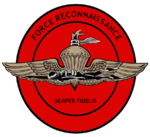
Force Reconnaissance Company  1st Reconnaissance Battalion,
1st Reconnaissance Battalion,
 1st Marine Division
1st Marine DivisionMCB Camp Pendleton, CA  2nd Reconnaissance Battalion,
2nd Reconnaissance Battalion,
 2nd Marine Division
2nd Marine DivisionMCB Camp Lejeune, NC 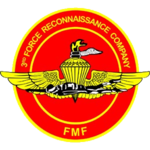
3rd Force Reconnaissance Company  Marine Forces Reserve,
Marine Forces Reserve,
 II Marine Expeditionary Force*
II Marine Expeditionary Force*Mobile, Alabama 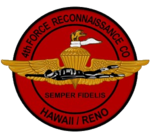
4th Force Reconnaissance Company  Marine Forces Reserve,
Marine Forces Reserve,
 I Marine Expeditionary Force*
I Marine Expeditionary Force*Alameda, CA * they supplement their respective Marine Air-Ground Task Force (MAGTF) when the primary active companies are unavailable. Deactivated
Logo Name Parent Command Location 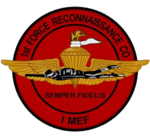
1st Force Reconnaissance Company  I Marine Expeditionary Force
I Marine Expeditionary ForceMCB Camp Pendleton, CA 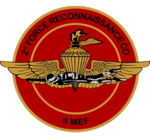
2nd Force Reconnaissance Company  II Marine Expeditionary Force
II Marine Expeditionary ForceMCB Camp Lejeune, NC 
5th Force Reconnaissance Company  III Marine Expeditionary Force
III Marine Expeditionary ForceMCB Camp Butler, Okinawa History
Main articles: FMF Amphibious Reconnaissance Battalion and Marine Corps Test Unit #1The historical roots of 'Force Recon' companies can be traced back to the antecedent Amphibious Reconnaissance Battalion, whose numerous pre-D–Day reconnoitering of enemy beaches during the Pacific campaigns of World War II proved the vitality of the Fleet Marine Force's amphibious reconnaissance doctrine. This unique unit reported directly to the landing force commander, which exercised his availability of receiving important intelligence at his disposal.
Formed initially as a company-size element from the Observer Group, under the command of Major James L. Jones, they were amongst the first—along with the early Navy Combat Demolition Units (the predecessor to the Underwater Demolition Teams [i.e. the Navy SEALs])—to embark from submarines; most of their missions complemented those of the NCDU and the UDT. The 'amphibious reconnaissance' doctrine clearly outlined that the recon Marines duties consisted of scouting the littoral areas, or beachhead, to inland; to test the soil permeability of a possible beach landing, or to clear any obstacles that may hinder an amphibious assault, and to observe any sign of enemy activity. The Navy UDT were tasked to provide the same, but from off the coastline to the littoral, or adjacent beach areas.[10]
Jones and his recon Marines scouted the Japanese-fortified beaches and observed the terrain, materials or other entities, primarily reporting to the force commander of any vital intelligence, or mission-oriented importance. Although Jones's Marines were all exceptionally skilled combatant divers, or frogmen, they usually inserted by boats—mostly due to the multiple radios [primary and contingent] they carried, as relaying communication to the landing force commander was paramount; and time means of sending in a platoon-sized element, with any means of heavy firepower (mortars, machineguns, etc.) at their disposal since they were greatly outnumbered and isolated from other major Marine forces, whom are still embarked on the destroyer-transport ships.[6]
By the end of World War II, the Amphib Recon Battalion terminated its command; its Marines either filled the ranks of other infantry platoons, or folded into the Scout (Tank) companies, and the newly formed division reconnaissance companies. This force-level reconnaissance element wasn't reestablished until the early-1950s when the Amphibious Reconnaissance Battalions were assembled for preliminary operations in Korea. Their efforts were proven that gaining beforehand the knowledge of the enemy in the event of a major operation was extremely crucial to safeguarding the men, and provided better operational planning.
The Korean War introduced the new concept of using rotary-wing aircraft to the Marine Corps in combat employment for logistics and rapid troop transport. Also, the atomic age was emerging and caused concerns within the military leaders. The Commandant of the Marine Corps, General Lemuel Shepherd acted upon creating an un-institutionalized test unit, the "Marine Corps Test Unit#1" (or MCTU#1), to research and experiment in new and improvised combative tactics, methods in preparing the Marine Corps in operating strategically, in cohesion or against, the use of nuclear weapons.[11]
Many of the conceptual ideas for Force Recon were pioneered by Major Bruce F. Meyers, the test unit's "Reconnaissance/Pathfinder Project Officer" from MCTU #1's Plans and Development (P&D) Section. His position can be seen as an unillustrated subsidiary to an 'operations' (G-6) and 'training' (G-7) officer. Major Meyers tested many methods for the 'Recon Platoon' various innovative techniques and evaluated their results for use for parachuting and pathfinding missions, in conjunction of using its heliborne and aircraft wing assets adding 'deeper' reconnaissance penetration capabilities. This new found capability enabled reconnaissance Marines the extreme advantage of operating further behind enemy lines.[1]
The MCTU#1's Reconnaissance Platoon, commanded by Captain Joseph Taylor, founded and adopted the more modern 'force reconnaissance' doctrine, methods which were instrumented by Major Meyers. They were developing and performing innovative clandestine insertion methods before the Navy SEALs and the Army's "Green Berets"; techniques such as the submarine locking -in and -out methods, underwater "blow and go" ascends, high altitude, low opening, or HALO and (-high opening) HAHO parachute insertions.[1]
MCTU#1 has concluded that parachute reconnaissance and pathfinding capabilities would exist at force-level, the Fleet Marine Force (the highest command echelon of the United States Marine Corps). At first, the concept was to be formed into a "Force Recon Battalion"—this battalion would have as many 'force recon' companies as there were division-wing MAGTFs in the Marine operating forces. Recognizing the limited budget during the fiscal year of 1957, it was recommended that instead, it be formed at company-sized elements, for the west and east coast.[1] In July 1957, The MCTU#1 was amalgamated into the existing 1st Amphibious Reconnaissance Battalion; the next day, the battalion cased its colors and redesignated it as "1st Force Reconnaissance Company". Although the test unit was no longer operating, Meyers continued to research and test more innovative methods.
Major Meyers and his top swimmers and senior officers of the company would test and train in submarine lock-in and -out methods and ascending techniques. While cross-trained by the Navy's Master Divers, they learned the operation of the early rebreather systems, and advanced open water swimming. Meyers understood that his recon Marines will be operating 50 to 150 miles away from their littoral or operating area, or from any naval support; in order to get his Marines out of a "hot" area, extraction techniques needed to be developed. Bruce Meyer's 1st FORECON, along with 1st Recon Company and 1st Marine Aircraft Wing were aware of the McGuire and STABO systems that were used by the United States Army's Special Forces and agreed that it had defects and disadvantages. The Marine Corp created a system that was more simplified rig that had greater capacity, the Special Personnel Insertion and Extraction (SPIE) rig.[1]
The CIA's highly secretive Special Activities Division (SAD) and more specifically its elite Special Operations Group (SOG) recruits operators from Marine Force Recon.[12] In addition, joint Force Recon and CIA operations go back to the famed MACV-SOG group during the Vietnam War and still exist to this day.[13]
Weapons Planning Group (Code 121)
The Reconnaissance/Surveillance Section of the Weapons Planning Group, Landing Force Development Center at Quantico introduced Force Recon to new technological methods of achieving their objective. Many of the tests and evaluations that were tried, resembled the tests of MCTU #1. However, MCTU #1 were testing in methods of inserting reconnaissance teams "deep" in the battlefield. The Weapons Planning Group (Code 121) provided the basis of equipment and instruments that would become instrumental to recon Marines. Beacons for helicopter guidance, laser designators for the guidance of ordnance, laser rangefinders, and many more were tested.[14]
During the Vietnam War, one of the reconnaissance officers of Code 121, then- Major Alex Lee, brought most of his testing experiences to 3rd Force Reconnaissance Company, when he was assigned as the commanding officer in 1969-1970. He formed Force Recon's missions that are still distinct today: remote sensor operations. The Surveillance and Reconnaissance Center (SRC) [predecessor to the Surveillance, Reconnaissance, and Intelligence Group (SRIG)] was formed within the III Marine Amphibious Force (IIIMAF). The obsolete pathfinding operations were taken over by the newer beacons and homing devices.[14]
Operations
Vietnam War, 1965-1974
3rd Force Reconnaissance Company was activated, trained, fought and deactivated during the Vietnam War. Activated in September 1965 as one of the first group of add-on units to meet demands of operations in the South Vietnam ( Activated in September 1965 as one of the first group of add on units to meet demands of operations in Viet Nam, the Company formed at Camp LeJeune, N.C. and satellite on Second Force Reconnaissance Company that was under strength due to the demands for trained Force Recon Marines assigned to First Force in country. Facilities, cadre and equipment for training were provided by Second Force.
Volunteers were solicited from throughout the Marine Corps and the first four months were devoted to bringing the company up to strength in personnel. Beginning in January 1966 all operational personnel departed Camp LeJeune to train in the Caribbean and Panama. Returning to North Carolina in March, final preparations were carried out to meet the projected deployment date in May 1966. The expected deployment of the entire Company did not occur, but a two Platoon Detachment embarked on the USS Boxer, transited through the Suez Canal, and arrived in country in time to be introduced to combat in Operation Hastings as part of The Special Landing Force in early July 1966.
The Company (-) dropped to a not combat ready readiness status. Headquarters Marine Corps transferred several Officers and numerous Staff Non Commissioned Officers immediately after the Detachment departed. In mid-June the Company (-) was alerted to deploy immediately. Due to the reduced personnel readiness status, HQMC changed the deployment plan and ordered that a Platoon be assigned to deploy with First Battalion, 26th Marines that had been activated at Camp Pendleton. The remainder of the Company was ordered to move to Camp Pendleton to refit.
At the conclusion of Hastings the Detachment was attached to Third Reconnaissance Battalion that had just arrived in Phu Bai from Da Nang, having been replaced by the First Reconnaissance Battalion that had just begun arriving with the First Marine Division. Shortly, they were joined by the Platoon that had come in country with 1/26.
They patrolled in Thua Tin Province until early January, 1967, when a task organized Special Purpose group carried out a prisoner rescue attempt. The remainder were sent to Khe Sahn where they developed the intelligence of a large enemy buildup, that was the prelude to The Hill Fights that occurred in April 1967.
Reunited, what was left of the three Platoons, returned to Phu Bai to await the arrival of the Company(-). Having been brought up to strength and operational readiness, the Company was reunited on April 27, 1966, just in time for the NVA offensive to seize Quang Tri Province. The logistics element arrive at the “ Ramp” at Dong Ha just in time for the opening salvos of the NVA artillery attacks that would continue daily until late Autumn.
The operational element experienced a mortar attack in Phu Bai at the same time resulting in several shrapnel wounds, only one of which, required evacuation. The new arrivals were integrated with combat veterans and the entire eighteen teams conducted a zone reconnaissance in the Cobi Than Tan Valley east of Quey City before displacing to Dong Ha.
Upon arrival at Dong Ha in early May the Commanding Officer assumed command of Third Recon Battalion (Forward), which had reconnaissance responsibility for all of Quang Tri Province except the Khe Sahn TAOR (Tactical Area of Operations). The Company patrolled the area north of Highway nine to the DMZ, while the Battalion Company was targeted south of Highway Nine to the Thua Tin border. Occasional circumstances caused deviation from that concept, but, for the most part, those deviations were rare. Third Force continued that operational commitment until the Third Division left country in November 1969.
Third Force was placed under command of The Third Marine Expeditionary Force and operated in General Support of Three MAF until deactivated in mid 1970.
Mission Training Plan
For information regarding the preliminary training (selection and indoctrination) of Force Recon, see United States Marine Corps Reconnaissance Selection and Indoctrination.Training within the Company is outlined by the Mission Training Plan (MTP). It is used in conjunction with the training and exercises that are conducted by the Marine Expeditionary Units for their "Special Operations Capable" certification. It follows a systematic approach to training, and the emphasis is to "train as they expect to fight".
- "The best form of WELFARE for our Marines and sailors is first class training; this saves unnecessary casualties". —MTP quote by S-3 of FORECON companies.[5]
The Mission Training Plan has five phases, and is based on a two-year platoon cycle. Training is ongoing and continuous, and functions as if it were a loop. Before FORECON operators are "Special Operations Capable" they follow the Company's MTP, which underlines the training protocol of the Pre-deployment Training Program (PTP).
- Phase 1: Individual Training
- Phase 2: Unit Training
- Phase 3: MEU (SOC) Training
- Phase 4: MEU (SOC) Deployment
- Phase 5: MEU (SOC) Post Deployment
Phase 1
The first phase in FORECON's Mission Training Plan takes place within the MEU's Pre-deployment Training Program (PTP) Initial Training Phase. In order for Marines to become Force Recon operators, it is required to complete each course as they progress through the 'Accession Pipeline'. Although, there are other senior and veteran Marines that have already served with Force Recon, choosing to stay attached to the company only to repeat the 2-year platoon cycle continuously. Which ever the case, they both will attend their respective schools: the candidates traverse through the accession pipeline, as the recon veterans attend specialized schools—both participating in Phase 1 of the MTP.[5]
The recon candidates of Force Recon are required to obtain the designation of MOS 0326 [formerly 8654], Reconnaissance Man, Parachutist/Combatant Diver Qualified. In order to achieve that, they must attend the following courses.
Accession Pipeline
Further information: United States Marine Corps Reconnaissance Selection and Indoctrination#Accession Pipeline- Infantry Rifleman Course—Infantry Training Battalion, US Marine Corps Schools of Infantry (East or West)
- Basic Reconnaissance Course—United States Marine Corps School of Infantry (West)
- Survival, Evasion, Resistance and Escape (SERE) [Level "C"]/Navy Remote Training Sites; NAS Brunswick, Rangeley, Maine, and NAS North Island, Warner Springs, California.
- United States Marine Corps Combatant Diver Course—Navy Diving Salvage and Training Center, Naval Support Activity Panama City, Florida
- Basic Airborne Course—United States Army Airborne School, Fort Benning, Georgia
- Special Operations Training Group (SOTG)—I MEF, Camp Pendleton; II MEF, Camp Lejeune; III MEF, Camp S.D. Butler
- Multi Mission Parachute Course—CPS Complete Parachute Systems, Coolidge, Arizona
- High Risk Personnel (HRP) Course—MCB Quantico, Virginia
Special Schools
During the "Individual Training Phase", the candidates are undergoing the accession pipeline to become qualified MOS 0321 (Reconnaissance Man). After further training, the already-billeted Force Recon operators (who had already completed the required courses in the accession pipeline [basic recon, parachutist and diving, and SERE/HRP courses] attain MOS 0326 (Reconnaissance man, parachute and combatant diver qualified) and may continue to remain with FORECON after the 3-year rotation cycle. They may be selected for additional advanced cross-service training from other schools provided by the Special Operations Forces (SOF) units. Although these specialized schools are not necessarily required, they are highly encouraged.
Many Marine Corps 'training liaisons' represent the Marines at many cross-services schools, to ensure training slots and openings are met and filled by the Marines that requested, or were recommended, for advanced training.[5] Some of these courses may not be able to facilitate the Marine students, the instructors of these schools resort to complement the Marines' requested syllabus by designing subsidiary courses of the similar. This argument becomes clear on whether Marines may, or may not, actually attend the Basic Underwater Demolitions/SEAL (BUD/S). Nonetheless, in the past, selected operators within Force Recon had attended the courses of instructions provided by BUD/S Instructors and their completion is documented in their military Service Record Book (SRB) or Officer Qualification Record (OQR).
- US Army Ranger School-All team leaders and above
- US Army Recon and Surveillance Leaders Course—All team leaders and above
- US Army Pathfinder Course—All team leaders and above
- Low-Level Static Line/Military Free Fall Jumpmaster School—two per platoon
- Mountain Leaders (Summer/Winter) Course—one per team
- USMC Scout Sniper Course—one per team
- US Army Jump Master School—two per platoon
- HRST Master Course—two per platoon
- Dive Supervisor Course—two per platoon
- LAR V Technician Course—two per platoon
- Ammunition Drivers Course—two per platoon
- Laser Operators Course —one per team
Phase 2
The second phase of the MTP also takes place during the MEU's PTP Initial Training Phase.
Training Cell (T-Cell)
The Training Cell (T-Cell) is regulated by the experienced staff non-commissioned officers (SNCOs) of FMF Recon company's Operations Section (S-3). This removes the responsibility of coordinating training from the platoon headquarters, and permits them to train with their men (rather than to just oversee the training).
- "Fight as you train, train as you fight!"—quote by unknown.[5]
An additional and no less important advantage to the T-Cell is that it acts as a training ground for future platoon sergeants. Those assigned to the T-Cell are all highly trained and experienced operators. Some have deployed as platoon sergeants, and some have not. Experienced FORECON operators within T-Cell monitor, evaluate and improve the training to ensure that exercises meet real-world conditions.[5]
- Advanced Long Range Communications Package (3 weeks)—It is conducted by the Company Communications Section. As the term Deep reconnaissance indicates, the platoon will operate well forward of other forces. In order to report observations, call for fires or extract, all members need to have a complete and thorough knowledge of the sophisticated communication equipment carried. It includes manual Morse code, and long-range high frequency (HF), satellite, multi-band, and digital communications.
- Weapons and Tactics Package (3 weeks)—Involves 5000-8000 rounds fired from the M4 carbine equipped with a Special Operations Peculiar Modification kit and the MEU(SOC) Pistol (.45 ACP). A live fire and maneuvering exercise in immediate action (IA) drills within close range of rotary wing support, as well as transportation, is conducted on the third week. As the Marines become familiar with their weapons, they conduct field exercise, force-on-force, live-fire drills using a militarized version of the Simunitions kit called the Special Effects Small Arms Marking Systems, or SESAMS. The Marking Cartridge ammunition contains a sabot and a small, plastic round encasing a colored detergent or paint, usually red or blue.
- Threat Weapons Familiarization Package(1 week)—Concludes "knowledge of weapons" with identification and operation of threat weapons used by adversaries of the United States. Threat Weapons include assault, automatic and mobilized weapons.
- Force Fires Package—Gives the Marines a working knowledge of fixed and rotary wing close air support and Naval Gun Surface Fire (NGSF) by using the AN/PEQ-1A Laser Acquisition Marker (SOFLAM) to "paint" their targets.
- Mobile Reconnaissance Package—Covers operating and maintaining the M998 HMMWV and the Interim Fast Attack Vehicle. Rapid deployment of FORECON requires fast mobilization. The current IFAV is a replacement of the two earlier FAVs, the M-151A2 and the Chenowth FAV that were employed in the 1980s and 1990s.
- Advanced Airborne Package—Extremely important to Force Recon for inserting Marines behind enemy lines. In this three-week period, Marines will transition from conventional Low Level Static Line Low Level Static Line (LLSL) insertions into the hallmark HAHO techniques. Usually it consists of consecutive night jumps with night combat equipment, but HAHO training is done in the Paraloft of the S3 Section using a complex virtual reality-based (VR) computer system. While wearing a VR headset device, the Marines hang suspended from the Paraloft ceiling that resembles the MC-5 Ram Air parachute. Many simulations are factored in this Virtual Reality Parachute Simulation; it allows the Marine to jump at high altitudes and visually check his main canopy for proper deployment, alleviate malfunctions, to cutaway and deploy a reserve parachute, then employ guidance and control to an unmarked drop zone (DZ).
- Combat Trauma Package—Examination of first aid and medical treatment that can prepare Marines in many realistic scenarios where Marines can become casualties. This package is built for Marines to give them confidence and knowledge to apply medical attention to themselves or others while operating in hazard environments whether they are engaged in combat or not.
- Amphibious Training Package (2 weeks)—While Marines were introduced to amphibious reconnaissance from the BRC, the T-Cell outlines the Amphibious Training package before they are attached to a MEU(SOC), this package refines their ability to conduct amphibious operations, and conventional and selected maritime special operations capabilities incorporating all their skills for Marines to work as a team. Refreshes long-range nautical navigation, and refines the platoon SOP for conducting hydrographic surveys. Launch and recovery is from a variety of naval vessels, including surface combatants and submarines. This training takes place at Seal Beach and San Diego, California on the west coast; and Onslow Beach, North Carolina on the east coast.
- Combatant Dive Package—Designed for concentrating on the unit's capabilities in the water. They will learn more about the LAR-V rebreather as they have been taught at the USMC Combatant Dive Course. The T-Cell will introduce the Diver Propulsion Device (DPD) and the "buddy line", a 15–20-foot (4.6–6.1 m) pipe made from composite plastics that every Marine is attached to when diving. This ensures that the team remain close together as the water may be impossible for visuals contact in subsurface swimming.[15]
Other training packages are available to mold the Marines into a fully functional Recon unit, including long range patrolling in desert areas, such as Twentynine Palms or MCAS Yuma, mountainous terrain and other environments relevant in peacetime or conflict. At the end of Phase 2 Training, the platoon is completely stood up in all aspects of the long-range reconnaissance mission. More importantly, they have spent 6-months of 'platoon-oriented' training together.[5]
Phase 3
Special Operations Training Group (SOTG)
See also: Special Operations Training GroupThis 6-month training phase emphasizing more in the direct action, or "black operations". It is conducted by the Special Operations Training Group (SOTG). This phase takes place during the MEU's PTP Intermediate Training Phase. These courses involves both aspects of maritime and urbanized environments and how to apply close quarters combat and science in demolition, gas/oil platform (GOPLAT) training, cordon and search, Visit, Board, Search, and Seizure (VBSS), shipboard assaults training and humanitarian operations.[16] The recon operators get the chance to train in unfamiliar urban areas and maritime structures.[5]
Phase 4
Once the SOC Certification Final Training Phase is finished, the MEU with the detached Force Recon platoon as a functionable special operations capable force. Then they sail on a six-month deployment. This long deployment are known as the 'Deployment Phases' to Force Recon, they sail from either three locations, off the east or west coast, or Okinawa. The I MEF on the west would deploy its Marine Expeditionary Units (MEUs) to the western Pacific and the II MEF's MEUs on the east coast sails across the Atlantic Ocean to either the Mediterranean Sea or the Persian Gulf. The III MEF's 31st MEU in Okinawa is to be used as a contingency for reinforced support of an area spanning from southwest Asia to the central Pacific. The III MEF is the only MEF of the FMF that is permanently fully deployed at all times.
 Whether garrisoned on land or aboard ship, along with their naval counterpart, training is constant while at sea. These Marines are firing a modified Springfield .45 ACP, the MEU(SOC) pistol.
Whether garrisoned on land or aboard ship, along with their naval counterpart, training is constant while at sea. These Marines are firing a modified Springfield .45 ACP, the MEU(SOC) pistol.
While Force Recon is afloat, they still remain focused on their self-disciplined training sessions. They conduct small arms live fire training on the deck of the ships and physical fitness training. In many cases, foreign maritime forces alike participate in joint exercises or training maneuvers, such as the Royal Thai Marine Corps, British Royal Marines, and Australian Forces. But while they may be training, the MEU are capable of projecting fully forward deployed operational task forces. Thus, epitomizing the infamous Marine Corps slogan, "force-in-readiness".
Phase 5
The last phase is the post-deployment phase. After 18-months of training and deployment, the platoon is granted 30-days of military leave. Once a Force Recon operator has finished deployment, they have a decision to make. What makes Force Recon unique from Division Recon, and the other SOFs, is the career style that is emplaced in the Force Recon company structure. They can choose to stay with the Force Recon Company and continue their assignment with the MEU, recycling its loop cycle; or they can get release from the FORECON company and go back to their original assignment, whether it being administration, motor transport, or infantry. However, on average, approximately 50% of the platoon will leave, their time in Force having expired.[5]
Equipment
For information on the general equipment of reconnaissance Marines, see United States Marine Corps Reconnaissance Battalions#Table of Equipment.The primary weapons used by both Division and FMF Recon assets are typically the same standard-issued weapons in the arsenal of the Marine Corps. However, since Force Recon's missions are directly involved in parachuting and underwater insertions, they demand weapons and equipment that are essential to their job. Their equipment reflects on which ever tasks that have been assigned by the MAGTF, MEF, or MEU commander; either direct action (black) or deep recon (green) operations.
Table of Equipment (T/E)
Some equipment only fits the needs for one particular mission over another. There is however some equipment that is used for both black and green operations, and these pieces of gear are usually combat vests, flak and armor jackets (or systems), and harnesses for use in hasty extraction measures.
Particularly during green operations, these missions normally encompass surveillance and reconnaissance. The equipment items carried into the field are usually cameras, scopes, and most importantly communications. Two recon Marines serve as radiomen in the team. Each team/platoon often brings two field radios that are able to withstand the elements of seawater, and rugged patrolling as they tread inland—if one radio fails, they resort to the supplemental radio. This is to ensure that vital information can always be sent to the commander, his S-3/S-6 shop, or similar intelligence collection agencies. More common in today's infrastructure, much of the intelligence-gathered information is sent to and processed by the Marine Expeditionary Force's "Surveillance, Reconnaissance, and Intelligence Group" (SRIG).
For black operations, the Marines carry weapons that are more of the close-quarter combative use; grenades, carbine rifles, sub-machine guns (SMGs), and any tool to use for breaching barricades and doors. They can be equipped with laser designating devices to "paint" their targets with laser-guiding coordinates to deliver payload to un-expecting targets. Since they are "bringing the fight to the enemy", they do not rely on camouflage as stealthy action is not a factor in these situations.
Equipment Mission Type M4A1 Close Quarters Battle Weapon (CQBW) Black Weapon M16A2/A4 Service Rifle Green Weapon M249 Squad Automatic Weapon Green Weapon MARPAT Combat Utility Uniform (Desert · Woodland) Green Uniform Combat Integrated Releasable Armor System (CIRAS) (Land or Maritime) - Combat gear MEU(SOC) Pistol with Safariland 6004 holster Black Weapon Interim Fast Attack Vehicle (IFAV) Black Vehicle Modular Tactical Vest Black Combat Gear Sniper/precision rifles Green Weapon M82A3 SASR .50 Anti-Materiel Weapon Black Weapon M240 General Purpose Machine Gun (GPMG) Black Weapon M2HB .50-cal Heavy Machine Gun Black Weapon Lightweight Helmet Black Combat gear NOMEX Uniform (Desert · Woodland) - Flight suit * modified for Force Recon operator use
- balaclava
- Aviator gloves
- rigger's belt
Black Uniform Breaching Shotguns Black Weapon Improved Load Bearing Equipment (ILBE) - Combat gear Long-range Communications, radio and SATCOM - AN/PRC-148—Racal Multiband Inter/Intra Team Radio (MBITR)
- AN/PRC-117F
- AN/PRC-138 (V2 ICOM)
Green Equipment Observation Scopes - Kowa TSN-822
- DRS Technologies "Nightstar"
Green Equipment Man Pack Secondary Imagery Dissemination System (MPSIDS) Green Equipment M2120 SOPHIE Long Range Thermal Imager Green Equipment AN/PEQ-1A Special Operations Forces Laser Marker (SOFLAM) Green Equipment Defense Advanced GPS Receiver (DAGR) Green Equipment Special equipment
In addition to the SCUBA equipment used in amphibious mission-essential tasks, Force Recon maintains and operates parachutes. This is the main difference and separation from Division Reconnaissance—all FORECON operators are required to be parachutists. The parachutist equipment is stored in the Force Reconnaissance's Parachute Loft.
Parachute pack systems—The parachute is one of the trademarks of Force Recon, throughout its existence the operators have extensively used a wide variety of parachutes. In the mid-1950s, they used the T-10, then later adopting the Capewell canopy release which provided a cut-away to reduce the deadly effect of drag. The T-10 became the most frequented parachute; which had two variants, one for low-level static line (LLSL) and the other for military free fall (MFF) descends. They had numerous parachutes listed under the Table of Equipment (T/E) that had been contained in the Paraloft. Even in its formative days in the Marine Corps Test Unit#1, the operators and testers of the Naval Parachute Unit (NPU) at El Centro had tested and sported numerous parachutes, adding modifications and suggestions that soon were adopted by other parachutists. By the 1990s, the MC-4 and MC-5 Ram Air Parachutes became the feasible choice, as it allows more detailed and accurate landing in smaller areas, easy to control—especially during oscillation of the canopy. Plus, it was formed to modulate between the LLSL and MFF without having to consort to a different pack.
These are parachutes that are still contained in the T/E of the Parachute Loft, however some may not be currently in use:
- T-10
- MC1-B
- MC-series* (MC-4, MC-5) [* Ram Air]
- * Canopies (Main & Reserve): Surface area 370 square feet (34 m2)
- * Altitude range: 3,000 feet (910 m) AG> to 30,000 feet (9,100 m) ft MSL
- * Forward speed: 15–25 MPH
- * Rate of descent: 4–18 ft/sec
- * Maximum Load: 700 pounds (320 kg)
- Multi-Mission Parachute System (MMPS) [currently being implemented—replacing the older MC-5]
Parachutist Individual Equipment Kit (PIEK)—The PIEK contains all the Force Recon's parachutist clothing and equipment assigned by Force Recon's Paraloft. They are used for the high-altitude MFFs (HAHO or HALO) and LLSL parachute operations. Due to extreme cold encountered during high altitude parachute operations, the parachutist must have protection from the environment.
- Gore-Tex Jumpsuit
- Polartec Jumpsuit Liner
- Cotton Ripstop Jumpsuit
- Flyer's Gloves
- Gore-Tex Cold-weather Gloves
- Overboots
- MA2-30 Altimeter
- Helmet
- Flyer's Helmet Bag
- Flyer's Kitbag—used to carry operator's rucksack, ammunition, communications, etc.
Single Action Release Personal Equipment Lowering Equipment (SARPELS)—The Force Recon operators are equipped with a complete equipment lowering system for both LLSL and MFF parachute operations. It allows them carry various configurations of all their individual mission-essential equipment, usually contained within their Flyer's Kitbag. SARPELS provides easy access to their weapons and equipment upon parachute landing and has a single-action release capability. It can be front or rear mounted, whichever is preferred. Once they have descended to about 100 feet (30 m) above the surface, they use the SARPEL to release their gear (weapons/kitbag), dropping it below them while still attached to their harness by a 25-foot (7.6 m) rope. It is used to minimize injuries in landing due to heavy load of equipment. The parachustists must maneuver themselves in order not to drop onto their gear during parachute landing falls.
- SARPELS Cargo Carrier
- Horizontal & Vertical Cargo Carrier Securing Straps
- Single Action Release Handle
- MFF Equipment Attaching Strap
- 15-foot (4.6 m) LLSL Lowering Line
- 8-foot (2.4 m) MFF Lowering Line
Creed
Realizing it is my choice and my choice alone to be a Reconnaissance Marine, I accept all challenges involved with this profession. Forever shall I strive to maintain the tremendous reputation of those who went before me.
Exceeding beyond the limitations set down by others shall be my goal. Sacrificing personal comforts and dedicating myself to the completion of the reconnaissance mission shall be my life. Physical fitness, mental attitude, and high ethics—The title of Recon Marine is my honor.
Conquering all obstacles, both large and small, I shall never quit. To quit, to surrender, to give up is to fail. To be a Recon Marine is to surpass failure; To overcome, to adapt and to do whatever it takes to complete the mission.
On the battlefield, as in all areas of life, I shall stand tall above the competition. Through professional pride, integrity, and teamwork, I shall be the example for all Marines to emulate.
Never shall I forget the principles I accepted to become a Recon Marine. Honor, Perseverance, Spirit and Heart. A Recon Marine can speak without saying a word and achieve what others can only imagine.
See also
- Marine Corps Special Operations Capable Forces
- MARSOC—Marine Special Operations Command
- Semper Fidelis
- Special Activities Division
Notes
- ^ a b c d e Meyers, Bruce F. (2000). Fortune Favors the Brave: The Story of First Force Recon. Annapolis, Maryland: Naval Institute Press.
- ^ a b c Pushies, Fred J (2003). "Chapter 1: History". Marine Force Recon. Zenith Imprint. pp. 18–19. ISBN 9780760310113.
- ^ Fleet Marine Force Manual (FMFM) 2-1, Intelligence, (Sep 1980).
- ^ Marine Corps Warfighting Program (MCWP) 2.15.1, Remote Sensor Operations.
- ^ a b c d e f g h i Patrick A. Rogers, Strong Men Armed: The Marine Corps 1st Force Reconnaissance Company, theaccuraterifle.com Part II: Volume 4, Number 1 (Manchester, CT: Feb 2001)
- ^ a b Meyers, Bruce F. (2004). Swift, Silent, and Deadly: Marine Amphibious Reconnaissance in the Pacific, 1942-1945. Annapolis, MD: Naval Institute Press. ISBN 1591144841.
- ^ Melton, Cpl. Ken (2006-08-11). "2nd MSOB activates, Force Recon evolves". http://www.marines.mil/units/marsoc/Pages/2006/2nd%20MSOB%20activates,%20Force%20Recon%20evolves.aspx.
- ^ "1st MSOB stand up marks evolution of 1st Force Recon". United States Marine Corps. 2006-12-13. Archived from the original on 2008-06-15. http://web.archive.org/web/20080615173454/http://www.marines.mil/units/marsoc/Pages/2006/1st+MSOB+stand+up+marks+evolution+of+1st+Force+Recon.aspx. Retrieved 2008-11-23.
- ^ Military.com
- ^ Fleet Training Publication 167
- ^ Ray W. Stubbe, AARUGHA!: History of Specialized and Force-level Reconnaissance Activities and Units of the United States Marine Corps, 1900-1974, Fleet Marine Reference Publication 12-21 (MCB Quantico, HQMC: Historical Division, 1981).
- ^ Waller, Douglas (2003-02-03). "The CIA Secret Army". TIME (Time Inc). http://www.time.com/time/covers/1101030203/.
- ^ Plaster, John L. (1997). SOG: The Secret Wars of America's Commandos in Vietnam. New York: Simon & Schuster. ISBN 0684811057.
- ^ a b Lee, Alex (1995). Force Recon Command: 3rd Force Recon Company in Vietnam, 1969—70. New York City: Random House Publishing Group. ISBN 0804110239.
- ^ Operational Requirements Document, Underwater Reconnaissance Capability
- ^ MCO 3502.3A, Marine Expeditionary Unit (Special Operations Capable) Predeployment Training Program
References
 This article incorporates public domain material from websites or documents of the United States Marine Corps.
This article incorporates public domain material from websites or documents of the United States Marine Corps.- Marine Administrative Message (MARADMIN) 417/07, Reconnaissance Marine Lateral Move Policy and Procedures [1]
- Field Manual (FM) 7-92, The Infantry Reconnaissance Platoon and Squad (Airborne, Air Assault, Light Infantry) [2]
- Marine Corps Reference Publication (MCRP) 2-1C, Marine Air Ground Task Force Intelligence Dissemination [3]
- Marine Corps Order (MCO) 3500.20B, Marine Corps Parachuting and Diving Policy and Program Administration [4]
- Marine Corps Warfighting Publication (MCWP) 2-1, Intelligence Operations [5]
- MCWP 2-15.1, Remote Sensor Operations [6]
- MCO 1543.12, Material Fielding Plan for the Combat Rubber Reconnaissance Craft (CRRC) [7]
- MCO 3500.42A, Marine Corps Helicopter Rope Suspension Techniques (HRST) Policy and Program Administration [8]
- MCO 1510.125, Individual Training Standards (ITS) Systems for Marine Combat Water Survival Training (MCWST) [9]
- MCO 3502.2A, Marine Expeditionary Units (Special Operations Capable) (MEU(SOC)) Special Skills Certification Program [10]
- MCO 3502.3A, Marine Expeditionary Unit (Special Operations Capable) Predeployment Training Program (PTP) [11]
- Operational Requirements Document (ORD) for an Underwater Reconnaissance Capability (URC)[12]
External links
- US Marine Corps
- Force Recon Association
- 3rd Force Reconnaissance Co.
- 4th Force Reconnaissance Co.
- ShadowSpear Special Operations Marine Force Reconnaissance
- SpecialOperations.com Marine Recon Page
- Marine 3rd Recon Bn., 31st MEU(SOC)
- Recon Marines
- Global Security USMC Unit Listings
- SpecWarNet: USMC Recon Battalions
Categories:
Wikimedia Foundation. 2010.

